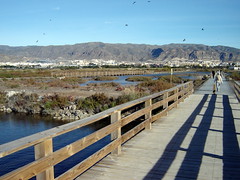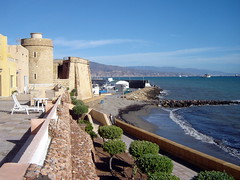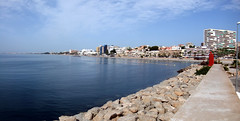
Dead Man’s Grip
September 11, 2013
Book reviews, Brighton & Hove, England, Robert Bovington book review, books, crime fiction, Peter James, Robert Bovington Leave a comment
 Dead Man’s Grip by Peter James
Dead Man’s Grip by Peter James
My rating: 5 of 5 stars
“Dead Man’s Grip” by Peter James
A Review by Robert Bovington
Location: A balcony in Andalusia
Diane: “Are you going to sit out there reading all day?”
Bob: “No. I’ve nearly finished this chapter.”
Bob finishes the chapter of Peter James’ latest thriller and reluctantly goes indoors to help his wife.
***********************
It is often like this when I read Peter’s Roy Grace novels. It is as though the books are stuck to my hands with superglue, which is most appropriate in the case of “Dead Man’s Grip” because one of the murders in the book involves the ultra strong adhesive.
This book is totally gripping. As usual, most of the action takes place in the vibrant city of Brighton and Hove. Student Tony Revere is killed which is rather unfortunate for the unsuspecting characters who are directly or indirectly involved in the fatal traffic accident. His American parents have Mafia connections and hire “Tooth”, a psychotic hit man to exact terrible revenge on those involved with their son’s death.
As with all the books in the Roy Grace series, the attention to detail is exemplary, especially police procedure – author Peter James’ painstaking research ensures that the police action is believable. His characters, too, are credible. There are the normal suspects – in this sense I mean Roy Grace’s team including sidekick Glenn Branson and the politically incorrect Norman Potting. Also featured are the threads from previous books including Roy’s girlfriend Cleo and his missing wife Sandy.
This is another addictive crime thriller and I particularly like the Brighton connection because I, like Peter James, grew up in the area.
I do, however, sometimes wonder whether the crimes are a bit far fetched. Or are they! I think I’ll remain in Spain rather than return to my roots!
other blogs by Robert Bovington:
|
“Photographs of Spain”
|
|
|
“Spanish Impressions”
|
|
|
“postcards from Spain”
|
|
|
“you couldn’t make it up!”
|
|
|
“a grumpy old man in Spain”
|
|
|
“Spanish Expressions”
|
|
|
“Spanish Art”
|
|
|
“Books About Spain”
|
The Girl Who Played With Fire – a review
September 11, 2013
Book reviews, Robert Bovington book review, books, Millennium Trilogy, Robert Bovington, Stieg Larsson 1 Comment
 The Girl Who Played with Fire by Stieg Larsson
The Girl Who Played with Fire by Stieg Larsson
My rating: 5 of 5 stars
“The Girl Who Played With Fire”
There ought be a health warning with this book – I found it so enjoyable, I couldn’t put it down and I therefore sat reading all day instead of going for a walk.
I really enjoyed “The Girl with the Dragon Tattoo” and couldn’t wait to start reading the sequel. In my opinion, this second book of the “Millennium Trilogy” is even better.
We get to know more of the enigmatic Lisbeth Salander who is wanted by
the police in connection with some brutal murders. Of course, our heroine (if we can call someone that has been labelled a raving, sociopathic, murdering, satanist, lesbian a heroine) is eventually found to be innocent of the crimes. More than that, we get to understand more of why Lisbeth is the way she is.
There are other interesting characters, both good and evil including the other main character from the first book, journalist Mikael Blomkvist.
This book is full of excitement and twists and turns and I can’t wait to read the third book in the trilogy. What a shame that the author Stieg Larsson died before writing further books. I’d love to read more about Lisbeth Salander!
other blogs by Robert Bovington:
|
“Photographs of Spain”
|
|
|
“Spanish Impressions”
|
|
|
“postcards from Spain”
|
|
|
“you couldn’t make it up!”
|
|
|
“a grumpy old man in Spain”
|
|
|
“Spanish Expressions”
|
|
|
“Spanish Art”
|
|
|
“Books About Spain”
|
What’s Behind The Curtain?
September 11, 2013
Art, non-pc, Robert Bovington art, art exhibition, Duquesa de Alba, Waldi Wrobel Leave a comment
in one of artist Waldo Wrobel’s exhibitions…
 |
| Duquesa de Alba – a painting of by Waldi Wrobel |
 |
| Jesuscrisis – a painting of by Waldi Wrobel |
other blogs by Robert Bovington:
|
“Photographs of Spain”
|
|
|
“Spanish Impressions”
|
|
|
“postcards from Spain”
|
|
|
“you couldn’t make it up!”
|
|
|
“a grumpy old man in Spain”
|
|
|
“Spanish Expressions”
|
|
|
“Spanish Art”
|
|
|
“Books About Spain”
|
Familiar Spanish Travels (book review)
September 8, 2013
Book reviews, Robert Bovington, Travel & Places book review, books, Robert Bovington, Spain, Spanish Travel Leave a comment
Familiar Spanish Travels by William Dean Howells
My rating: 2 of 5 stars
“Familiar Spanish Travels” by William Dean Howells
A review by Robert Bovington
In October 1911, American William Dean Howells travelled to Spain. The author wrote about his experiences in “Familiar Spanish Travels”.
As an avid reader of books about Spain, I have mixed feelings about this book. Certainly, I did not enjoy it as much as other books that I have read on the subject. I found Howells’ literary style too verbose. I wonder whether the author thought: “Why use two or three pithy adjectives when two or three pages of text will do the same job!”
He describes with great detail the strangers that he encounters on his travels, yet often provides little detail on the principal sights. Many of Howells’ sentences are inordinately long – 40, 50 words or more! Yet, despite his longwinded descriptions, Howells manages to convey his thoughts to the reader in both a poetic and an extremely descriptive manner. The reader can easily imagine the bleakness of the Meseta and the “insurpassably dirty and dangerous” gipsy quarters of Granada and Seville. Howells certainly was not, what we today call, politically correct. He frequently describes some of the Spanish women as fat. Nor did the author view his surroundings with rose tinted spectacles. He mentions bad breakfasts; freezing hotels, cold rainy streets and “the thick and noisome stench” of Cervantes former home in Valladolid. But he waxed lyrical about a great deal of his experiences too: the incomparable grandeur of Burgos Cathedral; the glorious masterpiece that is Murillo’s “Vision of St Anthony”; the unparalleled beauty of the Alhambra and the magnificent structure that is the Puente Nuevo in Ronda are shortened versions of just some of his descriptions.
I know people’s tastes are different but what really surprised me was the author’s likes and dislikes regarding the places he visited. He did not like Córdoba but, to be fair, it was raining during his visit and he described the houses as “wet and chill”. However, he was also disappointed in that city’s beautiful Mezquita. Yet he really liked Algeciras! Certainly, from the author’s text, I gathered that he preferred ‘people watching’ to visiting the famous sights, which probably explains the imbalance between his descriptions of people and his accounts of the places visited. But, then, the whole expedition was unbalanced. He spent only half an hour in Toledo’s magnificent Cathedral and not much longer in the Mezquita, yet he visited Seville Cathedral every day during his fortnight’s stay! He appears to have enjoyed Madrid, especially the Prado and he was greatly taken with Granada though, more for the views from within and without the Alhambra than for the wonderful Arabic architecture. He preferred the Palace of Charles V to the Nasrid Palaces in that magnificent monument to the Moors rule in Spain.
Notwithstanding the author’s idiosyncrasies, “Familiar Spanish Travels” will probably be an enjoyable read for those readers who wish to partake of a “warts and all” commentary of life in early 2oth century Spain.
Robert Bovington
April 2011
|
“Photographs of Spain”
|
|
|
“Spanish Impressions”
|
|
|
“postcards from Spain”
|
|
|
“you couldn’t make it up!”
|
|
|
“a grumpy old man in Spain”
|
|
|
“Spanish Expressions”
|
|
|
“Spanish Art”
|
|
|
“Books About Spain”
|
As I Walked Out One Midsummer Morning (Book Review)
September 8, 2013
Book reviews book review, books, Laurie Lee, Robert Bovington, Spain Leave a comment
 As I Walked Out One Midsummer Morning by Laurie Lee
As I Walked Out One Midsummer Morning by Laurie Lee
My rating: 5 of 5 stars
As I Walked Out One Midsummer Morning (1969) is an autobiographical account of an epic journey around Spain in the nineteen thirties.
It is 1934 and Laurie Lee, the author, is a young man. He leaves the security of his Cotswold home to embark on an adventure.
Initially he travels to London and ekes out an existence by playing the violin and by labouring on a London building site. He decides to go to Spain. It seems a rash decision because the young lad’s choice of destination is based on the fact that he knows a phrase of Spanish – “¿Puede por favor dame un vaso de agua?” – “Will you please give me a glass of water?”
For a year, he tramps through Spain, from Vigo in the north to Almuñécar on the south coast. During this voyage, he experiences a country that ranges from utter desolation to extreme beauty. He manages to eat by a earning a few pesetas playing his violin. He sleeps at night in his blanket under an open sky or in a cheap, rough posada though occasionally he is rewarded with the warm and generous hospitality of poor village people that he meets along the way.
Laurie Lee provides the reader with a vivid account of life in Spain during the bleak years leading up to the Spanish Civil War. I enjoy reading travel books, especially those about Spain. “As I Walked Out One Midsummer Morning” is as good as any I have read even though many of the places he visits – Vigo, Valladolid, Cádiz, Tarifa – are described as squalid, dark, decrepit, acrid, and scruffy. Even Seville is both “dazzling and squalid” according to the author. He does praise some of the places he visits- Toro, Segovia, Toledo – who wouldn’t! However, Lee’s descriptions of the places and peoples that he has encountered are couched in an extremely well written and sometimes poetic prose.
Laurie Lee must have been a good communicator. If we are to believe that he only had one phrase of Spanish then he did extremely well communicating with the people on his travels. His first port of call was Vigo and, I suspect that in July 1935, the ordinary people of that city would have spoken Galician. He would no doubt acquire more words of Spanish as he travelled through Spain but in Córdoba, Seville, Cádiz, Algeciras, Málaga and his final destination, Almuñecar, he would have encountered the Andaluz dialect. A novice in Castilian Spanish might experience some difficulty in understanding the spoken word of the ordinary people of Andalusia.
I enjoyed this book very much. I would recommend “As I Walked Out One Midsummer Morning” as a thoroughly good read.
Robert Bovington
March 2011
other blogs by Robert Bovington:
|
“Photographs of Spain”
|
|
|
“Spanish Impressions”
|
|
|
“postcards from Spain”
|
|
|
“you couldn’t make it up!”
|
|
|
“a grumpy old man in Spain”
|
|
|
“Spanish Expressions”
|
|
|
“Spanish Art”
|
|
|
“Books About Spain”
|
A walk in the South Downs National Park
September 7, 2013
England, Sussex, Travel & Places East Sussex, England, Robert Bovington, Rodmell, South Downs National Park, Sussex, Telscombe Leave a comment
On Bank Holiday Monday (26 Aug 2013), I went for an enjoyable walk with my brother Mike.
We walked across part of the Sussex Downs
 We started from the ‘Smugglers Rest’ pub/restaurant in Telscombe, Peacehaven, East Sussex. On my previous visits, some years ago, it was known as the ‘Badgers Watch’.
We started from the ‘Smugglers Rest’ pub/restaurant in Telscombe, Peacehaven, East Sussex. On my previous visits, some years ago, it was known as the ‘Badgers Watch’.
From there, we journeyed over part of the Sussex Downs, starting from Telscombe Tye, an area of common land between the coast and Telscombe Village.
 |
| Telscombe Village Church |
through farmland…
and arrived at the ‘Abergavenny Arms’ in Rodmell…
We had a couple of pints in the attractive beer garden before restarting our walk back to Telscombe.
|
NOTE:
|
|
About 500 yards down the lane at the side of the pub. is Monk’s House, the home of the author Virginia Woolf for twenty-one years until her death in 1941. When I lived in the UK, I was a member of the National Trust and visited the little cottage on two occasions.
|
more photos of our walk…
One of the signposts on the walk was marked “To the Pub”!
other blogs by Robert Bovington:
|
“Photographs of Spain”
|
|
|
“Spanish Impressions”
|
|
|
“postcards from Spain”
|
|
|
“you couldn’t make it up!”
|
|
|
“a grumpy old man in Spain”
|
|
|
“Spanish Expressions”
|
|
|
“Spanish Art”
|
|
|
“Books About Spain”
|


















